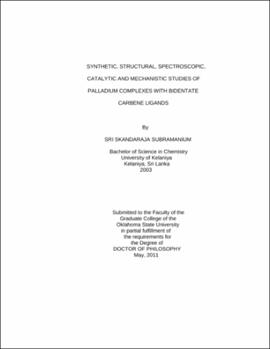| dc.contributor.advisor | Slaughter, LeGrande M. | |
| dc.contributor.author | Subramanium, Sri Skandaraja | |
| dc.date.accessioned | 2013-11-26T08:21:30Z | |
| dc.date.available | 2013-11-26T08:21:30Z | |
| dc.date.issued | 2011-05 | |
| dc.identifier.uri | https://hdl.handle.net/11244/6476 | |
| dc.description.abstract | Scope and Method of Study: | |
| dc.description.abstract | Findings and Conclusions: | |
| dc.description.abstract | Carbenes are strong donor ligands widely used in metal catalyzed organic reactions. In early work, N-heterocyctic carbenes (NHCs) were considered as mimics for tertiary phosphine ligands, but subsequently they were shown to be superior to phosphine ligands in terms of activity and scope for many catalytic reactions. Bidentate carbenes are potentially more stable than monodentate carbene due to the chelate effect. A possible pathway for tuning the metal reactivity is bite angle variation. Donor abilities of imidazole-derived bis(NHCs), bis acyclic diaminocarbenes, bitriazole bis(NHCs), "abnormal" C4-bound bis(NHCs), and bis(phosphines), and thus their trans influence and effect on metal electrophilicity, were studied using methylisocyanide as an IR probe. Donor abilities of ligands were correlated with structural parameters such as bite angle, and carbene dihedral angle. Acetonitrile adducts of [(chelate)Pd]2+ complexes were examined as catalysts for electrophilic cyclizations of acetylenic aldehydes with alcohols to form cyclic alkenyl ethers, hydroarylation of alkynes with aromatic C-H bonds, and polarized Nazarov cyclizations of dialkenyl ketones. The most effective catalysts were those with ligands which were identified as less effective donor ligands by MeNC IR probe studies. The study identified that donor type is the most important determinant of metal electrophilicity, but steric effects are also important. Bis(carbene) ligands can be tuned to support electrophilic catalysis by metals, in contrast to the prevailing use of mono-NHCs to engender electron rich metal centers. Bis(ADC) complexes can be tuned to support electrophilic catalysis by electronic tuning without altering the sterics. Cationic methylpalladium bis(NHC) complexes were synthesized and characterized for first time. Mechanistic details of the migratory insertion of CO into methylpalladium complexes, which is a key step in CO/ethylene polymerization, also have been investigated for the first time with NHC ligands on palladium. | |
| dc.format | application/pdf | |
| dc.language | en_US | |
| dc.rights | Copyright is held by the author who has granted the Oklahoma State University Library the non-exclusive right to share this material in its institutional repository. Contact Digital Library Services at lib-dls@okstate.edu or 405-744-9161 for the permission policy on the use, reproduction or distribution of this material. | |
| dc.title | Synthetic, structural, spectroscopic, catalytic and mechanistic studies of palladium complexes with bidentate carbene ligands | |
| dc.contributor.committeeMember | Bunce, Richard A. | |
| dc.contributor.committeeMember | Ausman, Kevin Douglas | |
| dc.contributor.committeeMember | Benson, Stacy D. | |
| dc.contributor.committeeMember | Wicksted, James P. | |
| osu.filename | Subramanium_okstate_0664D_11400 | |
| osu.accesstype | Open Access | |
| dc.type.genre | Dissertation | |
| dc.type.material | Text | |
| dc.subject.keywords | acyclic diaminocarbene | |
| dc.subject.keywords | (adc) | |
| dc.subject.keywords | bis(phosphine) | |
| dc.subject.keywords | cationic palladium(ii) complexes | |
| dc.subject.keywords | methylisocyanide ir probe study | |
| thesis.degree.discipline | Chemistry | |
| thesis.degree.grantor | Oklahoma State University | |
